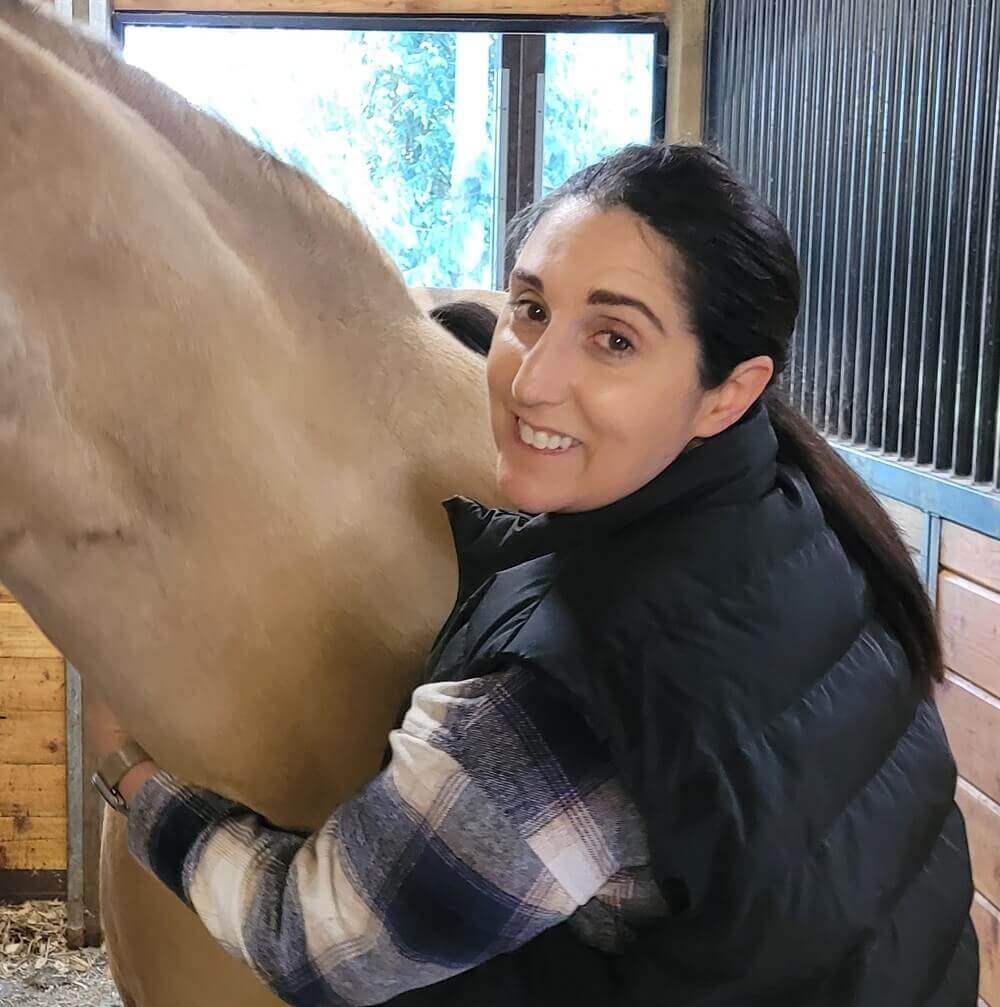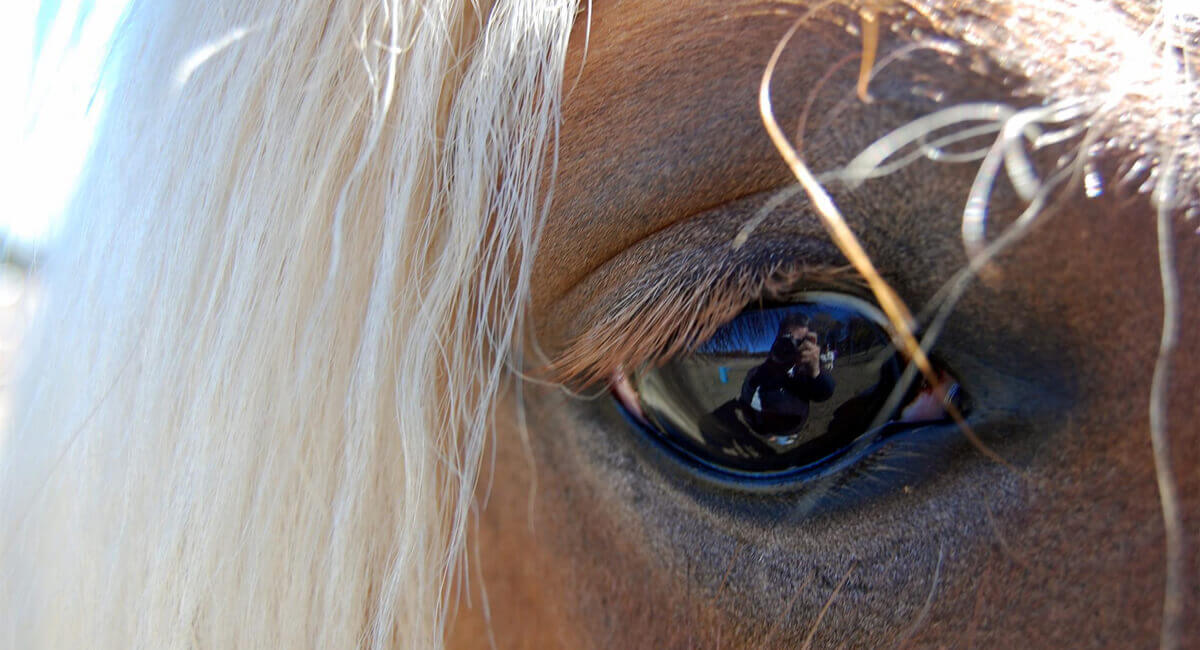Certain Colors in a Horse’s Environment Can Affect Behavior
By Michael Hipp and Victoria Doulgerakis
How horses see color has been a much-studied topic in recent years. Not only does it matter what colors horses see, it matters how they see them.
How Horses See Color
The retina is the major factor in vision, and the horse’s rectangular pupil extends their area of visual perception beyond a human’s. Color is perceived in the retina by cones. While humans have three types of cones, which sense blue, red, and yellow-green light, horses only have two types of cones, which sense blue and green, and variations of these two colors, but they do not sense red or shades of red.1 However, it is not just what colors horses see, but how they interact with those colors which determine behavior.
Horses Prefer Colors in Their Spectrums
Researchers determined that horses prefer colors that are within their spectrum and avoid those that they cannot see. This was verified by one study using different color water buckets, where horses tended to prefer blue colored buckets over red ones, and light-colored buckets over darker colors.2
For many decades in horse jumping, how horses perceive the colors of the poles was never considered. More recently science has helped show designers construct jumps with different colored poles for improved visibility and performance. In one study, the color of the poles determined take off angles, length of jumps, and landing distances.3
Because horses are prey animals and always desire to feel safe, we are learning that most of the time they prefer colors in the spectrums they see to provide a safe environment.
Choosing The Right Colors Can Help Behavior
A client expressed concern when her mare would not leave her stall at night to relieve herself. Every morning the stall was filled with urine and manure requiring new bedding every day. She asked why the horses in the barn stalls stayed inside at night and were messier than the horses in the pasture stalls that regularly left their stalls at night and kept cleaner bedding. It was explained that the reason was the lighting.
In the barn a white light was being left on so the client could see in an emergency. However, this white light was also taking away the night vision from the horses in the barn. As a result, they were staying inside where it was safe from predators they couldn’t perceive in the dark. It was suggested that a red light be used instead of white because horses cannot see red and thus the red light would help them preserve their night vision. After making the change the horses felt safe to roam freely and the stalls were easier to clean each day.
Choosing the right colors can also change the behavior of more than just horses. On another visit it was suggested to a client to paint the ceiling a certain shade of blue. This shade has been shown in architectural history to confuse both bees (or wasps) and birds that sometimes plague areas inside our barns by making them think they are outside instead of safely in a barn, so they do not build nests inside.
Consult an Equine Color Consultant
If your horse is exhibiting bad behavior, avoids certain areas, is not eating or drinking as they should, or shows any other signs of behavioral concern, sometimes the best thing you can do along with working with your vet is to consult with an expert on how horses perceive their environment, which for them is a lot about the colors that surround them.
Colors can not only make horses feel safer and more confident in their spheres of life, but colors can also create calmness and eliminate many issues a horse exhibits when they aren’t happy in their space. Colors matter to them, just as they do to us. By consulting with a color expert, you can begin to understand how your horse sees the world. Happy horses require less maintenance than bored or emotional horses who act out. They also have more positive energy to return to us when their world provides it to them in the colors that surround them.
References:
1. Iowa State University Extension, Equine Science, “Vision in the Equine”, retrieved 5/22/2024. https://www.extension.iastate.edu/equine/vision-equine.
2. Equinews, Kentucky Equine Research, “Color Preferences Among Horses”, June 24, 2020. https://ker.com/equinews/color-preferences-among-horses.
3. Paul SC, Stevens M. Horse vision and obstacle visibility in horseracing. Appl Anim Behav Sci. 2020 Jan;222:104882. doi: 10.1016/j.applanim.2019.104882. PMID: 32025069; PMCID: PMC6988441.

Michael Hipp
Michael is a lifelong student of the horse and has worked with conservation districts all over Washington State to protect natural resources while improving the lives of the horses and their humans. Michael began consulting with horse owners in 2012 while teaching biological and animal sciences at Panhandle State University in Oklahoma. Today Hipp Equine Consulting serves horse owners across the country as well as conducting workshops at local stables on property management, horse behavior, chore management, and many other practical topics. [email protected] (425)-314-9980

Victoria Doulgerakis
Victoria Doulgerakis studied interior design at the University of Alaska. In 2017 she started her own color consulting business, Colorpsych, in Lynnwood, Washington, focusing on the psychology of color and how color is perceived and how it affects your emotional health and your personal space, both for humans and horses. colorpsych.com
See this article in the July 2024 online edition:
July 2024

Michael Hipp is a lifelong student of the horse, from his childhood in Texas ranch country to his work with conservation districts all over Washington State protecting natural resources while also improving the lives of horses and their human companions. Hipp Equine Consulting serves horse owners across the country as well as conducting workshops at local stables on property management, horse behavior, chore management, and many other practical topics. [email protected] | (425)-314-9980
Victoria Doulgerakis studied interior design at the University of Alaska and in 2017 started her own color consulting business, Colorpsych, in Lynnwood, Washington, focusing on the psychology of color and how it’s perceived and affects emotional health and personal space, both for humans and horses. colorpsych.com






